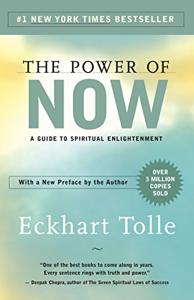
Want to learn the ideas in The Power of Now better than ever? Read the world’s #1 book summary of The Power of Now by Eckhart Tolle here.
Read a brief 1-Page Summary or watch video summaries curated by our expert team. Note: this book guide is not affiliated with or endorsed by the publisher or author, and we always encourage you to purchase and read the full book.
Video Summaries of The Power of Now
We’ve scoured the Internet for the very best videos on The Power of Now, from high-quality videos summaries to interviews or commentary by Eckhart Tolle.
1-Page Summary of The Power of Now
Overview
The book offers insight on how you can become a more mindful communicator. It draws from Buddhist teachings and outlines ways to listen well, express your ideas effectively, and improve relationships with others.
Many of us spend our time either regretting the past or worrying about the future. We also hope that we can become happier and find enlightenment, but we don’t know how to do it. Eckhart Tolle provides readers with several methods for navigating their inner lives and relationships to the past, present and future in his book The Power of Now.
At the heart of Tolle’s philosophy is an emphasis on living in the present moment as a way to avoid most of the pain that we usually experience. The book focuses on how our minds cause us to suffer, and it offers many examples of this process. For example, we can trap ourselves in cycles of suffering by using our minds in certain ways.
The Power of Now has helped millions of people improve their lives. This includes improving relationships with others, and increasing self-esteem.
Big Idea #1: By ignoring the past and future, you can greatly improve your life.
Many people are seeking enlightenment and want to improve their lives. They don’t know which steps to take, so they’re stuck in the past or future, not realizing that there’s a way out of this trap. The first step is easy: we tend to live in the past or future, but we can simply focus on right now and be present.
Only the present is important, because nothing ever occurs in the past or future. Things happen only in a continuous stream of present moments. When you feel something, it’s always happening now. We say that things happened in the past when really they happened all at once and can’t be divided up into separate moments.
The past and the future are both made up of moments that have passed or will come. It’s not advantageous to worry about either, but it is good to live in the present because you’ll deal with problems as they arise instead of worrying about them.
For example, if you’re worried about a big task — like writing an essay or report — it can seem overwhelming and impossible to complete. However, if you just take it step by step — gathering the data, outlining your ideas, then writing the first draft of each chapter — you’ll finish more easily.
So, in order to be happy and live a good life, one needs to stop clinging on the past and fearing the future. One should just focus on living in the present moment.
Big Idea #2: A part of you needs to suffer in order to survive. Most of the suffering you experience is created by that part.
If you manage to live in the present, then when pain occurs, you don’t have to worry about your future or past. To deal with this pain, though, we must understand that it is self-created resistance to things that cannot be changed. This manifests itself as negative feelings on an emotional level.
Because you think so much about the past and the future, but can only live in the present (or now), things that are upsetting to you cannot be changed. This causes inner resistance and suffering. Another cause of suffering is a part of yourself that continues to exist because it needs your pain for its own survival. Since this painful part of yourself grows whenever you experience pain, it will try to make you miserable or sad.
This cycle can continue for a long time, until you finally identify with your pain-body. You’ll be afraid to let it go because doing so would put your identity at risk.
For example, when something annoys or frustrates you and causes you pain, your pain-body takes over. This makes it hard to think logically and act rationally, which just leads to more pain. Even though the source of all this pain is within yourself, there’s good news: since it’s self created, you can do something about it.






